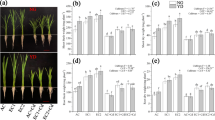Abstract
The responses of rice to the second degree contamination of copper were studied by pot experiments under free-air CO2 enrichment (FACE) with 570 μmol·mol−1 of CO2. The results showed that the content of copper in rice leaves was reduced with the CO2 concentration reaching 570 μmol·mol−1 and this happened more significantly under the second degree contamination of copper. Under FACE, activities of superoxide dismutase (SOD) enzyme in rice leaves treated by copper contamination were induced, whereas the contents of glutathione (GSH) and glutathione disulfide (GSSG) had no significant difference from the control. In the presence of ambient CO2, activities of SOD enzyme treated by copper pollution were suppressed during the whole rice growth, however, the contents of GSH and GSSG were induced at tillering and jointing stages, and then restored to the control levels in later growth under the second degree contamination of copper. With the rice growing, the content of malondialdehyde (MDA) rises continuously, but there had been no significant difference between the treatments at the same growth stage. Further studies are needed on the response mechanism of rice to Cu stress under elevated CO2.
Similar content being viewed by others
References
Broecker W S. Abrupt climate change: Debate or action. Chin Sci Bull, 2004, 49(18): 1997–2002
Wang G C, Wen Y P, Kong Q X, et al. CO2 background concentration in the atmosphere over the Chinese mainland. Chin Sci Bull, 2002, 47(14): 1217–1220
Keeling C D, Whorf T P, Wahlen M. Interannual extremes in the rate of rise of atmospheric carbon dioxide since 1980. Nature, 1995, 375:666–670
Lu J J, He W S, Zhou K Y, et al. Behavior of Zn, Cu, Pb and Cd in biota of Yangtze Estuary. Sci China Ser B-Chem, 2001, 44(Supp. 1):165–172
Wong S C, Li X D, Zhang G, et al. Heavy metals in agricultural soils of the Pearl River Delta, South China. Environ Pollut, 2000, 119:33–44
Kimball B A, Zhu J G, Cheng L, et al. Responses of agricultural crops to free-air CO2 enrichment. Chin J Appl Ecol (in Chinese), 2002, 13(10): 1323–1338
Jasoni R, Kane C, Green C, et al. Altered leaf and root emissions from onion (Allium cepa L.) grown under elevated CO2 conditions. Environ Exp Bot, 2004, 51: 273–780
Li C R, Liang Y H, Hew C S, et al. Responses of Rubisco and sucrose-metabolizing enzymes to different CO2 in a C3 tropical epiphytic orchid Oncidium Goldiana. Plant Sci, 2002, 163:313–320
Verma S, Dubey R S. Lead toxicity induces lipid peroxidation and alters the activities of antioxidant enzymes in growing rice plants. Plant Sci, 2003, 164: 645–655
Shah K, Kumar R G, Verma S, et al. Effect of cadmium on lipid peroxidation, superoxide anion generation and activities of antioxidant enzymes in growing rice seedlings. Plant Sci, 2001, 161:1135–1144
Xu J K, Yang L X, Wang Z Q, et al. Toxicity of copper on rice growth and accumulation of copper in rice grain in copper contaminated soil. Chemosphere, 2006, 62: 602–607
Cao Z H, Hu Z Y. Copper contamination in paddy soils irrigated with wastewater. Chemosphere, 2000, 41: 3–6
Liu G, Han Y, Zhou J G, et al. Rice-wheat rotational FACE platform I. System structure and control. Chin J Appl Eco (in Chinese), 2002, 13(10): 1253–1258
Hissin P J, Hilf R. A fluorometric method for the direct determination of oxidized and reduced glutathione in tissues. Anal Biochem, 1976, 74: 214–226
Marklund S, Marklund G. Involvement of the superoxide anionradical in the autooxidation of pyrogallol and a convenient assay for superoxide dismutase. Eur J Biochem, 1974, 47: 469–474
Bradford M M. A rapid and sensitive method for the quantitation of microgram quantities of protein utilizing the principle of protein-dye binding. Anal Biochem, 1976, 72: 248–254
Chen Y Q. Biochemistry Experiment Method and Technology (in Chinese). Beijing: Science Press, 2002. 197–199
Rønn R, Gavito M, Larsen J, et al. Response of free-living soil protozoa and microorganisms to elevated atmospheric CO2 and presence of mycorrhiza. Soil Biol Biochem, 2002, 34: 923–932
Hu J L, Lin X G, Chu H Y, et al. A review on soil microbial responses to elevated atmospheric CO2 concentration. Chin J Soil Sci, 2006, 37(3): 601–605
Idso S B, Idso K E. Effects of atmospheric CO2 enrichment on plant constituents related to animal and human health. Environ Exp Bot, 2001, 45: 179–199
Loladze I. Rising atmospheric CO2 and human nutrition: towards globally imbalanced plant stoichiometry. Trends Ecol Evol, 2002, 17:457–461
Lieffering M, Kim H Y, Kobayashi K, et al. The impact of elevated CO2 on the elemental concentrations of field-grown rice grains. Field Crop Res, 2004, 88: 279–286
Monnet F, Bordas F, Deluchat V, et al. Toxicity of copper excess on the lichen Dermatocarpon luridum: Antioxidant enzyme activities. Chemosphere, 2006, 65: 1806–1813
Tanyolac D, Ekmekci Y, Ünalan S, et al. Changes in photochemical and antioxidant enzyme activities in maize (Zea mays L.) leaves exposed to excess copper. Chemosphere, 2007, 67: 89–98
Zhang J F, Liu H, Sun Y Y, et al. Responses of the antioxidant defenses of the Goldfish Carassius auratus, exposed to 2,4-dichlorophenol. Environ Toxicol Phar, 2005, 19: 185–190
Author information
Authors and Affiliations
Corresponding authors
Additional information
Supported by the Key Project of the National Natural Science Foundation of China (Grant No. 40110817), the Knowledge Innovation Program of the Chinese Academy of Sciences (Grant No. KZCX3-SW-440), China Postdoctoral Science Foundation, and Jiangsu Planned Projects for Postdoctoral Research Funds
About this article
Cite this article
Jia, H., Guo, H., Yin, Y. et al. Responses of rice growth to copper stress under free-air CO2 enrichment (FACE). CHINESE SCI BULL 52, 2636–2641 (2007). https://doi.org/10.1007/s11434-007-0362-2
Received:
Accepted:
Issue Date:
DOI: https://doi.org/10.1007/s11434-007-0362-2




